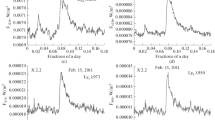Abstract
The results of long-term mesoscale observations in the microwave range are reviewed. The rationale for the resumption of observations at the Havana Radio Astronomy Station is justified. Domestic observations at a wavelength of λ5 cm have a long observation interval and can effectively complement the global series of observations. A comparative analysis of the results of solar observation in the radio range and satellite observations in the UV and X-ray range is performed. The value of continuous observations for the assessment of space weather factors is shown.





Similar content being viewed by others
REFERENCES
Covington, A.E., Solar Radio Emission at 10.7 cm, 1947–1968, J. R. Astron. Soc. Can., 1969, vol. 63, pp. 125–132.
Denisse, J.F., Microwave solar noise and sunspot, Astron. J., 1949, vol. 54, p. 183.
Dudok de Wit, T., Kretzschmar, M., Lilensten, J., and Woods, T., Finding the best proxies for the solar UV irradiance, Geophys. Res. Lett., 2009, vol. 36, 10107. https://doi.org/10.1029/2009GL037825
Floyd, L., Tobiska, W.K. and Cebula, R.P., Solar UV irradiance, its variation, and its relevance to the Earth, Adv. Space Res., 2002, vol. 29, pp. 1427–1440.
Henney, C.J., Toussaint, W.A., White, S.M., and Arge, C.N., Forecasting F10.7 with solar magnetic flux transport modeling, Space Weather, 2012, vol. 10. https://doi.org/10.1029/2011SW000748
Kundu, M.R., Solar active regions at millimeter wavelengths, Sol. Phys., 1970, vol. 13, pp. 348–356.
Pap, J.M., Fox, P., Fröhlich, C., Hudson, H.S., Kuhn, J., McCormack, J., North, G., Sprigg, W., and Wu, S.T., Solar Variability and Its Effects on Climate, Washington DC, American Geophysical Union, 2004, vol. 141.
Svalgaard, L. and Hudson, H.S., The solar microwave flux and the sunspot number, in SOHO-23: Understanding a Peculiar Solar Minimum, Cranmer, S.R., Hoeksema, J.T., and Kohl, J.L., Eds., San Francisco: Astronomical Society of the Pacific, 2010, vol. 428, pp. 325–328.
Tanaka, H., Castelli, J.P., Covington, A.E., Kruger, A., Landecker, T.L., and Tlamicha, A., Absolute calibration of solar radio flux density in the microwave region, Sol. Phys., 1973, vol. 29, pp. 243–262.
Tapping, K.F., The 10.7 cm solar radio flux (f10.7), Space Weather, 2013, vol. 11, no. 7, pp. 394–406.
Tapping, K.F. and Morton, D.C., The next generation of Canadian solar flux monitoring, J. Phys.: Conf. Ser., 2013, vol. 440, id 012039. https://doi.org/10.1088/1742-6596/440/1/012039
Tapping, K.F. and Valdés, J.J., Did the Sun change its behaviour during the decline of cycle 23 and into cycle 24?, Sol. Phys., 2011, vol. 272, pp. 337–350. https://doi.org/10.1007/s11207-011-9827-1
Funding
The study was supported by the Russian Foundation for Basic Research (project nos. 18-02-00098 and 18-52-34004) and the Ministry of Science, Technology, and the Environment of Cuba.
Author information
Authors and Affiliations
Corresponding author
Ethics declarations
The authors declare no conflict of interest.
Rights and permissions
About this article
Cite this article
Tlatov, A.G., Bogod, V.M., Pons, O. et al. Observation of the Radio Radiation Flux of the Sun and Flares at a Wavelength of 5 cm. Geomagn. Aeron. 60, 1087–1092 (2020). https://doi.org/10.1134/S0016793220080241
Received:
Revised:
Accepted:
Published:
Issue Date:
DOI: https://doi.org/10.1134/S0016793220080241




